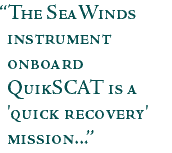

| Information courtesy of NASA's Jet Propulsion Laboratory. Additional information can be found at winds.jpl.nasa.gov |
Built in a record time of just 12 months, QuikScat will provide climatologists, meteorologists and oceanographers with daily, detailed snapshots of the winds swirling above the world's oceans. Labeled as NASA's next "El Niño watcher," QuikSCAT will be used to better understand global weather abnormalities and to generally improve weather forecasting. QuikSCAT's predecessor, NSCAT (NASA Scatterometer), a microwave radar scatterometer, measured near-surface wind vectors (both speed and direction) over the global oceans starting in August 1996. The QuikSCAT mission is a "quick recovery" mission to fill the gap created by the loss of data from NSCAT, after the satellite it was flying on lost power in June 1997. Winds play a major role in every aspect of weather on Earth. They directly affect the turbulent exchanges of heat, moisture and greenhouse gases between Earth's atmosphere and the ocean. To better understand their impact on oceans and improve weather forecasting, QuikSCAT carries a state-of-the-art radar instrument called a scatterometer for a two-year science mission. Known as "SeaWinds," this scatterometer operates by transmitting high-frequency microwave pulses to the ocean surface and measuring the "backscattered" or echoed radar pulses bounced back to the satellite. The instrument senses ripples caused by winds near the ocean's surface, from which scientists can compute the winds' speed and direction. The instruments can acquire hundreds of times more observations of surface wind velocity each day than can ships and buoys, and are the only remote-sensing systems able to provide continuous, accurate and high-resolution measurements of both wind speeds and direction regardless of weather conditions. SeaWinds uses a rotating dish antenna with two spot beams that sweep in a circular pattern. The antenna radiates microwave pulses at a frequency of 13.4 gigahertz across broad regions on Earth's surface. The instrument is currently collecting data over ocean, land, and ice in a continuous, 1,800-kilometer-wide band, making approximately 400,000 measurements and covering 90% of Earth's surface each day. next: History of Scatterometry |
by Steve Graham 
Scatterometry
Other Relevant Ocean Fact Sheets: |